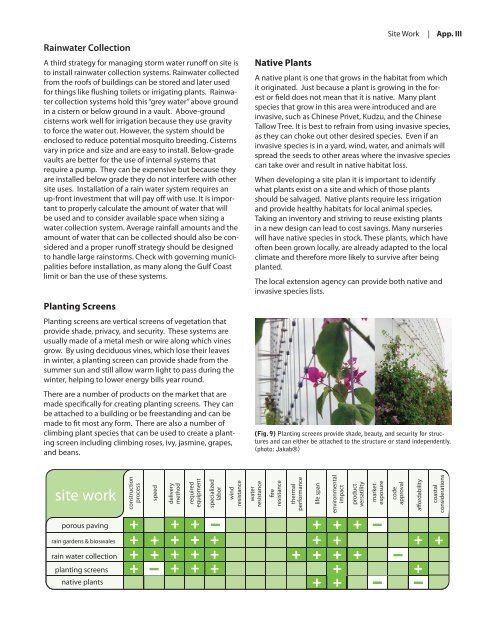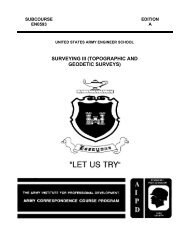Alternative Construction Research Guide - GCCDS
Alternative Construction Research Guide - GCCDS
Alternative Construction Research Guide - GCCDS
Create successful ePaper yourself
Turn your PDF publications into a flip-book with our unique Google optimized e-Paper software.
Rainwater CollectionA third strategy for managing storm water runoff on site isto install rainwater collection systems. Rainwater collectedfrom the roofs of buildings can be stored and later usedfor things like flushing toilets or irrigating plants. Rainwatercollection systems hold this “grey water” above groundin a cistern or below ground in a vault. Above-groundcisterns work well for irrigation because they use gravityto force the water out. However, the system should beenclosed to reduce potential mosquito breeding. Cisternsvary in price and size and are easy to install. Below-gradevaults are better for the use of internal systems thatrequire a pump. They can be expensive but because theyare installed below grade they do not interfere with othersite uses. Installation of a rain water system requires anup-front investment that will pay off with use. It is importantto properly calculate the amount of water that willbe used and to consider available space when sizing awater collection system. Average rainfall amounts and theamount of water that can be collected should also be consideredand a proper runoff strategy should be designedto handle large rainstorms. Check with governing municipalitiesbefore installation, as many along the Gulf Coastlimit or ban the use of these systems.Planting ScreensPlanting screens are vertical screens of vegetation thatprovide shade, privacy, and security. These systems areusually made of a metal mesh or wire along which vinesgrow. By using deciduous vines, which lose their leavesin winter, a planting screen can provide shade from thesummer sun and still allow warm light to pass during thewinter, helping to lower energy bills year round.There are a number of products on the market that aremade specifically for creating planting screens. They canbe attached to a building or be freestanding and can bemade to fit most any form. There are also a number ofclimbing plant species that can be used to create a plantingscreen including climbing roses, ivy, jasmine, grapes,and beans.Site Work | App. IIINative PlantsA native plant is one that grows in the habitat from whichit originated. Just because a plant is growing in the forestor field does not mean that it is native. Many plantspecies that grow in this area were introduced and areinvasive, such as Chinese Privet, Kudzu, and the ChineseTallow Tree. It is best to refrain from using invasive species,as they can choke out other desired species. Even if aninvasive species is in a yard, wind, water, and animals willspread the seeds to other areas where the invasive speciescan take over and result in native habitat loss.When developing a site plan it is important to identifywhat plants exist on a site and which of those plantsshould be salvaged. Native plants require less irrigationand provide healthy habitats for local animal species.Taking an inventory and striving to reuse existing plantsin a new design can lead to cost savings. Many nurserieswill have native species in stock. These plants, which haveoften been grown locally, are already adapted to the localclimate and therefore more likely to survive after beingplanted.The local extension agency can provide both native andinvasive species lists.(Fig. 9) Planting screens provide shade, beauty, and security for structuresand can either be attached to the structure or stand independently.(photo: Jakab®)site workconstructionprocessspeeddeliverymethodrequiredequipmentspecializedlaborwindresistancewaterresistancefireresistancethermalperformancelife spanenvironmentalimpactproductversatilitymarketexposurecodeapprovalaffordabilitycoastalconsiderationsporous pavingrain gardens & bioswalesrain water collectionplanting screensnative plants
















